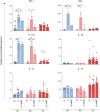The role of mucosal-associated invariant T cells in visceral leishmaniasis
- PMID: 36189274
- PMCID: PMC9521739
- DOI: 10.3389/fimmu.2022.926446
The role of mucosal-associated invariant T cells in visceral leishmaniasis
Abstract
Mucosal-associated invariant T (MAIT) cells are restricted by MR1 and are known to protect against bacterial and viral infections. Our understanding of the role of MAIT cells in parasitic infections, such as visceral leishmaniasis (VL) caused by protozoan parasites of Leishmania donovani, is limited. This study showed that in response to L. infantum, human peripheral blood MAIT cells from children with leishmaniasis produced TNF and IFN-γ in an MR1-dependent manner. The overall frequency of MAIT cells was inversely correlated with alanine aminotransferase levels, a specific marker of liver damage strongly associated with severe hepatic involvement in VL. In addition, there was a positive correlation between total protein levels and the frequency of IL-17A+ CD8+ MAIT cells, whereby reduced total protein levels are a marker of liver and kidney damage. Furthermore, the frequencies of IFN-γ+ and IL-10+ MAIT cells were inversely correlated with hemoglobin levels, a marker of severe anemia. In asymptomatic individuals and VL patients after treatment, MAIT cells also produced IL-17A, a cytokine signature associated with resistance to visceral leishmaniasis, suggesting that MAIT cells play important role in protecting against VL. In summary, these results broaden our understanding of MAIT-cell immunity to include protection against parasitic infections, with implications for MAIT-cell-based therapeutics and vaccines. At last, this study paves the way for the investigation of putative MAIT cell antigens that could exist in the context of Leishmania infection.
Keywords: IFN-γ+ MAIT; IL-17+MAIT; Leishmania; MAIT; MR1; TNF+MAIT; anti-parasitic activity.
Copyright © 2022 Moreira, Borges-Fernandes, Pascoal-Xavier, Ribeiro, Pereira, Pediongco, Araújo, Teixeira-Carvalho, de Carvalho, Mourão, Campos, Borges, Carneiro, Chen, Saunders, McConville, Tsuji, McCluskey, Martins-Filho, Eckle, Coelho-dos-Reis and Peruhype-Magalhães.
Conflict of interest statement
JM, ZC, and SE are inventor of patents describing MR1 antigens and MR1 tetramers. The remaining authors declare that the research was conducted in the absence of any commercial or financial relationships that could be construed as a potential conflict of interest.
Figures







Similar articles
-
MR1 blockade drives differential impact on integrative signatures based on circuits of circulating immune cells and soluble mediators in visceral leishmaniasis.Front Immunol. 2024 Aug 13;15:1373498. doi: 10.3389/fimmu.2024.1373498. eCollection 2024. Front Immunol. 2024. PMID: 39192975 Free PMC article.
-
Human liver CD8+ MAIT cells exert TCR/MR1-independent innate-like cytotoxicity in response to IL-15.J Hepatol. 2020 Sep;73(3):640-650. doi: 10.1016/j.jhep.2020.03.033. Epub 2020 Apr 2. J Hepatol. 2020. PMID: 32247824
-
MAIT cells accumulate in ovarian cancer-elicited ascites where they retain their capacity to respond to MR1 ligands and cytokine cues.Cancer Immunol Immunother. 2022 May;71(5):1259-1273. doi: 10.1007/s00262-021-03118-9. Epub 2021 Dec 2. Cancer Immunol Immunother. 2022. PMID: 34854949 Free PMC article.
-
Interleukin-17 producing mucosal associated invariant T cells - emerging players in chronic inflammatory diseases?Eur J Immunol. 2020 Aug;50(8):1098-1108. doi: 10.1002/eji.202048645. Epub 2020 Jul 15. Eur J Immunol. 2020. PMID: 32617963 Review.
-
MAIT cells as attractive vaccine targets.FEBS Lett. 2019 Jul;593(13):1627-1640. doi: 10.1002/1873-3468.13488. Epub 2019 Jun 27. FEBS Lett. 2019. PMID: 31206659 Review.
Cited by
-
MR1 blockade drives differential impact on integrative signatures based on circuits of circulating immune cells and soluble mediators in visceral leishmaniasis.Front Immunol. 2024 Aug 13;15:1373498. doi: 10.3389/fimmu.2024.1373498. eCollection 2024. Front Immunol. 2024. PMID: 39192975 Free PMC article.
-
CD4+ Th1 and Th17 responses and multifunctional CD8 T lymphocytes associated with cure or disease worsening in human visceral leishmaniasis.Front Immunol. 2024 Feb 12;15:1277557. doi: 10.3389/fimmu.2024.1277557. eCollection 2024. Front Immunol. 2024. PMID: 38410517 Free PMC article.
-
Phenotype and function of MAIT cells in patients with alveolar echinococcosis.Front Immunol. 2024 Mar 14;15:1343567. doi: 10.3389/fimmu.2024.1343567. eCollection 2024. Front Immunol. 2024. PMID: 38550591 Free PMC article.
References
-
- Porcelli S, Yockey CE, Brenner MB, Balk SP. Analysis of T cell antigen receptor (TCR) expression by human peripheral blood CD4-8- alpha/beta T cells demonstrates preferential use of several V beta genes and an invariant TCR alpha chain. J Exp Med (1993) 178:1–16. doi: 10.1084/jem.178.1.1 - DOI - PMC - PubMed
-
- Tilloy F, Treiner E, Park S-H, Garcia C, Lemonnier F, de la Salle H, et al. . An invariant T cell receptor α chain defines a novel TAP-independent major histocompatibility complex class ib–restricted α/β T cell subpopulation in mammals. J Exp Med (1999) 189:1907–21. doi: 10.1084/jem.189.12.1907 - DOI - PMC - PubMed
Publication types
MeSH terms
Substances
Grants and funding
LinkOut - more resources
Full Text Sources
Research Materials

